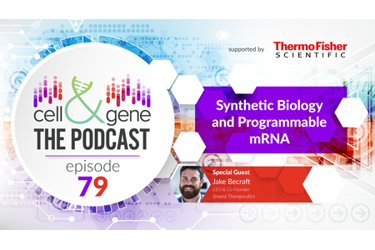What Are Smart mRNAs?

By Erin Harris, Editor-In-Chief, Cell & Gene
Follow Me On Twitter @ErinHarris_1

Cell & Gene: The Podcast features some of the CGT sector’s brightest leaders who share their expertise on the timeliest topics and trends. If you can’t tune in to every episode, I’ve got you covered. Here are highlights, quotes, and more from a recently aired episode.
The Episode:
Synthetic Biology And Programmable mRNA With Strand Therapeutics' Jake Becraft
Guest At-A-Glance
Jake Becraft is a synthetic biologist and biotech entrepreneur, as well as the co-founder and CEO of Strand Therapeutics. He started his career developing the SAfER platform at MIT, the world’s first synthetic biology programming language for mRNA. Beyond that work, his broader interests span synthetic biology, the intersection of hard-tech and biologically engineered therapeutics, and biologically engineered organism-machine interfaces. He is an inventor on a multitude of patents in the biotech/gene therapy space and has won numerous awards for his scientific and entrepreneurial achievements, including a Goldwater Scholarship, a Viterbi Fellowship, and an Amgen fellowship. He is an advocate among the life science entrepreneurial ecosystem for supporting founder-driven biotech startups and works to help increase young technical founders in biotech entrepreneurship.
Organization At-A-Glance
Strand Therapeutics is a biotech committed to transforming the lives of patients by developing first-in-class programmable mRNA therapeutics. Founded by leaders in mRNA-based synthetic biology at MIT, Strand is creating the first platform for programmable, long-acting mRNA therapeutics that are bioengineered to enable precise control of the location, timing, intensity, and duration of therapeutic activity. Strand’s mission is to develop improved treatment options for cancer and other life-threatening diseases. The company is headquartered in Boston.
Episode Highlights
Smart mRNA
Strand utilizes synthetic biology to genetically program mRNA to deliver therapies. Most people know of mRNA therapeutics as having been the savior of the COVID-19 pandemic. Becraft and his team began thinking about how they could build mRNA that could go beyond an injection of a vaccine into the arm, as that process becomes much more complicated when attempting to direct messenger RNA to areas of the body that cannot be directly injected, such as the kidney or a solid tumor. Solid tumors, for example, are deep within the body, and so the mRNA must first traverse the bloodstream, then reach the tumor, and then activate and express the therapeutic within the tumor.
As a result of his work at MIT and now at Strand, Becraft and his team have pioneered what they refer to as “smart mRNAs,” messenger RNAs that are engineered not only with therapeutics encoded in them but also with logic that has been built into the mRNA sequence itself. This restricts the mRNAs’ ability to express that therapeutic to only the cells that are being targeted. This means mRNA can travel anywhere in the body, but its therapeutic protein payload is allowed to act in only the appropriate locations. Strand’s genetic circuits allow them to turn off the mRNA when it lands in healthy cells. Indeed, Strand's technology is therapeutic-area and mRNA modality agnostic; therapeutic proteins are encoded onto modified, self-replicating, or circular mRNA backbones, which in turn are programmed with cell-specific sensors and circuits.
Top Quotes
7:35: We’re programing with the tools that evolution has given us. So, evolution has created all sorts of genetic regulatory elements and all sorts of ideas for how messenger RNA and DNA are processed – when genes turn on, when they turn off, and what we do is we use those genetic regulatory elements to achieve new ends.
11:15: The limitation that we’ve seen is one of localization and toxicity. Essentially when folks have used the signaling molecules synthetically, so synthetically produced the protein and then injected them into either directly into [solid] tumors or into the bloodstreams, you've had problems where … there is a signal that doesn't have localized activity within the tumor cell itself.
There’s More Where That Came From
The full-length episode delivers interesting details on synthetic biology, solid tumor treatment, Strand’s poster at ASCO on their Phase 1 trial design for its first-in-human STX-001, and much more. Listen in here or wherever you get your podcasts to hear the full story.
In addition, back in 2023, Becraft penned an article for Cell & Gene that is still relevant today and well worth your time. In the article, he shared some of his learnings working in the space and some practical thoughts for the future of the field of mRNA therapeutics.
